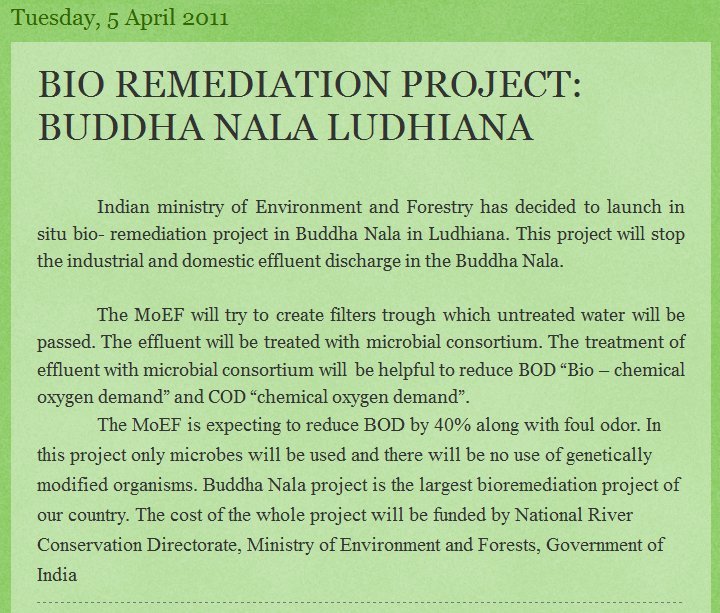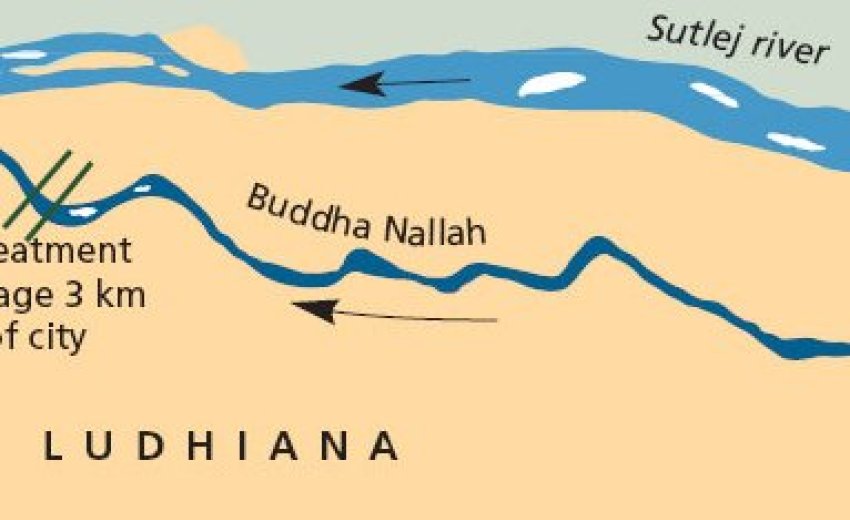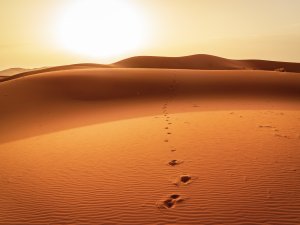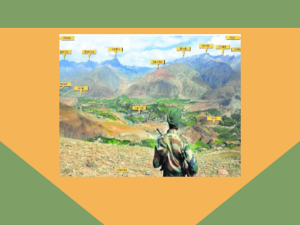Ludhiana lives to its reputation of being the most polluted city in the state. Industry of Ludhiana remains the most apparent polluting factor. Ludhiana city has about 250 large and medium scale units and 41,116 small scale units. Electroplating, heat treatment, cycle manufacturing, hosiery, machine parts, vegetable oils, dyeing process and chemical industries are the major categories. Nearly 22,000 industrial units of different categories are a major source of pollution. These units spread all over the city are basically concentrated in Industrial Area A, Industrial Area B, Focal Point, along both sides of GT Road towards Ambala and Jalandhar, Gaushalla Road, Chandigarh Road and Rahon Road. Some of the most important categories of industries in Ludhiana are hosiery and textile. This industry uses huge quantity of chemicals and various types of dyes. Other important category is electroplating and heat treatment which uses chrome, nickel and cyanide, which are highly toxic and harmful for public health. The rising population, increasing traffic volume, haphazard growth of cities, development of slum areas, rural to urban migration, perpetual shortage of funds, discharge of untreated solid wastes into the rivers and nullahs etc., are accentuating the pollution problem in Ludhiana.
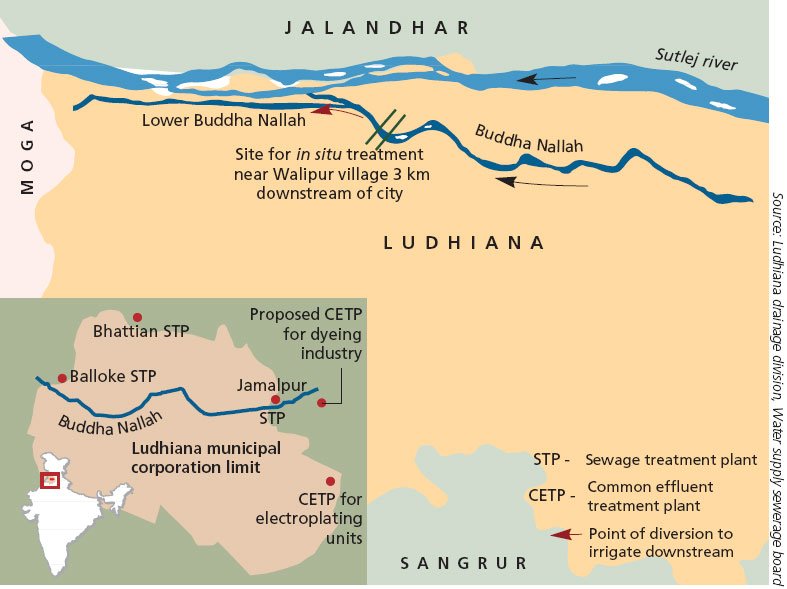
The major natural features of Ludhiana are the river Sutlej and its tributary, locally popular as Buddha Nullah. The most polluted water body of the city, Buddha Nullah flows silently, carrying pollutants throughout day and night. Buddha Nala, a narrow unlined canal, is the city's sole surface water resource. It is a seasonal tributary of the river Satluj originating at Bahlolpur, passing through Machhiwara and Ludhiana, it joins Satluj at Walipur Kalan in Ludhiana district. When we were young, we used to wash our hands and feet before going to Gurdwara Sahib at Machhiwara. It was used for bathing, washing and sometimes even for drinking. Buddha Nullah used to be a good source of fisheries several years ago and 56 fish species had been recorded in it in 1944. As Ludhiana developed and the industry started coming up, its condition deteriorated with pollution from the industry and the city. Later, only 18 species were found in it during 1970. In 1984, only 4 air - breathing species of fish could be recorded. Now the nullah is without any fish due to the high level toxicity in the water. According the State Department of Fisheries, the pollution of the Buddha Nullah has led to the drastic reduction in the fish yield in river Sutlej as well.[5] The water of the stream is polluted after it enters Ludhiana City.[4] It is now an open sewer rather than a stream. Once an asset to the city, the Nullah is now a source of public nuisance and poses a serious health hazard. While passing through Ludhiana city, it carries the sewage and industrial sludge of the city and is the important drainage system that disposes 25 km away in river Sutlej in a very unhygienic way. The large volume of domestic and industrial waste water has converted the Nullah to a virtually sewage drain. The seasonal functioning of some industries varies the amount and nature of pollution load in Buddha Nullah round the year. Flowing parallel to the Sutlej, the 31-km-long Buddah Nallah, of which about 14 km falls in Ludhiana, has, for decades, been polluted by industrial effluents, sewage water, solid waste from dairies, leather and electroplating industries and dumping of garbage.
Table 1.2: Concentration of pollutants in Ludhiana at STP outlets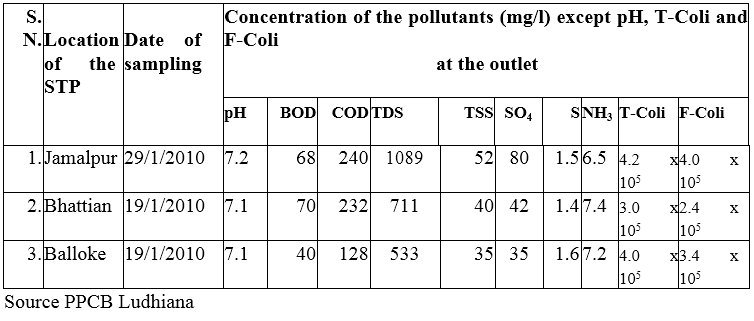
Ludhiana has no sewage treatment plant. Untreated domestic and industrial sewerage of the city is emptied into Buddha Nullah. The nullah, in turn, empties into the mighty Sutlej flowing nearby. Hundreds of tonnes of raw sewage from Ludhiana flows into the Sutlej every day and is distributed all over the state through irrigation canals. This polluted water is in turn used for growing food crops, vegetables and fruits and is a known carrier of diseases. A joint study by PGIMER and Punjab Pollution Control Board in 2008, revealed that in villages along the Nullah, calcium, magnesium, fluoride, mercury, beta-endosulphan and heptachlor were more than the permissible limit (MPL) in ground and tap waters. Plus the water had high concentration of COD and BOD (chemical and biochemical oxygen demand), ammonia, phosphate, chloride, chromium, arsenic and chlorpyrifos. The ground water also contains nickel and selenium, while the tap water has high concentration of lead, nickel and cadmium. According to PPCB, the Nullah water requires a sewage treatment capacity of at least 150 million imperial gallons (680,000 m3) per day for treatment while the present sewage treatment plants at Jamlapur, Nalloke and Bhattian have a combined capacity of 311 MLD.
In 2010, water samples taken from the Nullah, showed heavy metal content as quite high and the presence of uranium 1½ times the reference range. For example, chromium was 50 times the reference range, aluminum and iron 20 and 60 times higher, while concentration of silver, manganese, nickel and lead was equally high.
The pollution has led to increase in temperature, pH, hardness, B. O. D. and total solids in this Nullah. Now only septic conditions prevail in it (Kaur, 1997). Since the Nullah ultimately joins river Satluj, a major source of drinking water and fisheries in Punjab, at about 25 km from Ludhiana city, the river Satluj too is now getting polluted. It would, therefore, be useful from economic and public health points of view to assess the effect of this pollution on the immune system of fish which makes it vulnerable to diseases.
The Buddha Nullah remains the most polluted tributary in Punjab and has defied any solution so far. ll this despite of the central Government's effort to launch a "bioremediation technology" project to curb pollution caused by sewerage and industrial effluents in the Buddah Nallah. The project was estimated to cost Rs. 16 crore in the initial phase and it was to be borne by The National River Conservation Directorate of the Union government. It was expected to take one year for completion three years before but nothing useful has occurred till date.
Dyeing units and electroplating units are said to be major polluting industries. The Punjab Pollution Control Board (PPCB) is entrusted by Punjab Government to stop pollution in Punjab. PPCB tried to take action against 26 dyeing units in Ludhiana for polluting Buddha Nullah stream with pollutants There were specific inputs with the PPCB that dyeing industry was discharging pollutants in the Buddha Nullah that enters river Satluj. The effluent treatment plants at these units were found shut during a visit by the board recently against which the industry had protested. Board had also conducted surprise raids at electroplating units and initiated action for sealing and disconnection of 51 major violators, which were discharging untreated effluents into sewer. However, the situation has not changed much despite the halfhearted efforts of Punjab pollution Control Board as is evident from the visits of this researcher with his team from Tajpur to Walipur Kalan. The water from Buddha Nullah into Satluj at Walipur Kalan is quite black and it being a tiny portion converts the huge quantity of brownish Satluj water into black as well. The Satluj water of the river is collected in Harike Lake and this water is used for irrigation and water supply purposes in the southern part of Punjab and neighbouring state of Rajasthan. The State of Rajasthan has complained regarding the deteriorating quality of the water being received from Harike Lake. Effect on crops and health of the people in southern part of Punjab too is very damaging.
In view of the above, it is imperative that urgent steps are taken to depollute Buddha Nullah at the earliest for which the initiative taken by S Harwinder Singh Phoolka is appreciable. The project plan for this is outlined below:
Need:
Buddha Nullah is heavily polluted, having polluted not only the surface waters of Ludhiana city but also affecting the crops in Southern Punjab as well as Rajasthan when it merges into the Satluj river. Not only the flora and fauna is heavily affected but also the health and hygiene of millions of people. The beauty of the city is also lowered. It is important that the pollution of the Buddha Nullah is controlled without further delay before it causes an epidemic. The pollution agencies of the State, the state administration and the Central Government agencies have not been able to control this pollution. There is a need of mass effort to control it.
Purpose:
A team has been constituted by NGO "Purify Buddha Nallah" to evaluate the existing efforts, coordinate the various agencies and make the general public aware of the dangers of pollution by the Buddha Nullah and start a mass campaign for bringing it to its original glory where flora and fauna can survive and the water becomes usable for public consumption.
Vision: To make Buddha Nulla pollution free forever.
Mission: To depollute Buddha Nulla and plan for permanent solution.
Objectives:
1. Create an Organisational set up to carry out the mission
2. Information collection, collation and dissemination
3. Start public awareness campaign
4. Coordinate with agencies and social service organizations involved in pollution control
5. Pressuring Central and state Governments into action
6. Assist the implementing agencies in performing their tasks of pollution control
7. Perform service (kar sewa) to do manual cleaning when needed.
1. Organisation

2. Information collection, collation and dissemination
(a) Start point of pollution
(b) All types of pollution till it joins Satluj
(c) Sources of pollution
(d) Types of industries causing pollution
(e) Points of sewerage system and domestic waste causing pollution.
(f) Agencies disposing waste
(g) Locating/identifying alternatives instead of the Buddha Nullah as a place for waste disposal and defecation.
(h) NGOs and Government organizations involved in pollution control
(i) Effect of various agencies in pollution control
(j) How much effort is needed to control pollution in Buddha Nullah and to get it to original shape.
(k) Identifying agencies, organizations and individuals likely to assist
(l) Own manpower
(m) Fund position
3. Start Public Awareness campaign: Through contact, word-of-mouth, advertisements, seminars, conferences, banners, meetings etc., starting a public awareness campaign about the bad effects of pollution in Buddha Nullah and measures to be taken within Ludhiana and areas adjoining Buddha Nulla.
4. Coordination with agencies and social service organization involved in pollution control
(a) Government agencies including PPCB, Ministry of Environment, The National River Conservation Directorate of the Union government, District Administration etc.
(b) NGOs, social and religious organizations
(c) Youth Clubs
(d) General Public
5. Pressurizing Governments:
(a) Pressing central government to implement the "bioremediation technology" project estimated to cost Rs. 16 crore in the initial phase to be borne by The National River Conservation Directorate of the Union government.
(b) Pressing State Government to enforce Punjab Pollution Control Board, Ludhiana to stop polluting industries from discharging effluents into Buddha Nullah and set up common effluent treatment plant at the earliest.
(c) Pressing Municipal Corporation Ludhiana not to allow any garbage into or close to Buddha Nullah, channelize the sewerage system away from Buddha Nullah and set up a treatment plant for making it reusable.
(d) Press Forest Department to create a green belt along with the banks of Buddha Nullah.
(e) Press Fisheries department to study the effort required to make the Buddha Nullah fit for fishery and other natural fauna.
6. Assist the implementing agencies in performing their tasks of pollution control: assist Punjab Pollution Control Board, Municipal Corporation, Administration, Forest Department, Fisheries Department, Industries Department and Central government agencies in their effort to cleanse Buddha Nullah.
7. Perform service (kar sewa) to do manual cleaning when needed. Through public awareness start a mass campaign of manual cleaning of the entire Buddha Nullah as a one-time measure.
